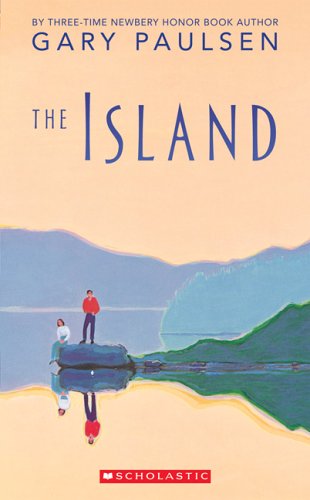 Book #1 for the 48-hour Book Challenge
Book #1 for the 48-hour Book Challenge
202 pages, 2.5 hours
I’ve never read Gary Paulsen’s Newbery Honor young adult novel, Hatchet, although I have read a lot about it and seen it recommended frequently. It’s a survival story, about a boy who grows into manhood by surviving in a harsh natural environment. According to Wikipedia this “coming of age by surviving in the wilderness” theme is a frequently repeated one in Paulsen’s more than 200 novels:
“Much of Paulsen’s work features the outdoors and highlights the importance of nature. He often uses “coming of age” themes in his novels, where a character masters the art of survival in isolation as a rite of passage to manhood and maturity.”
The Island tells the story of Wil, a teen who, with his parents, moves to a rural area of northern Wisconsin near a lake, Sucker Lake, with an unnamed island in the center of the lake. Wil sees the island while riding his bike, and he also finds a small rowboat conveniently abandoned on the shore so that he is able to row out to the island by himself. On the island, Wil discovers something about himself and about the world that he tries to put into writing, or into drawings of wildlife on the island, or into words of explanation for his parents and for his new friend, Susan. He is somewhat successful in his writing and drawing, less so in his verbal explanations.
The Island is an odd little book. I can see myself recommending it to teens who are adventure and nature lovers and also quite thoughtful, even philosophical. I’m not sure how often that combination of characteristics coincides. Not much happens in the novel; there’s a lot of description of the natural environment and quite a bit of philosophical musing. I would think the pace of the story would be a bit slow for many young adult readers. There’s a hint of romance, but it’s not really developed. The characters themselves, Wil and Susan, nip any budding of romance, in the bud so to speak, since Wil is on a quest of sorts to know and understand the natural world and himself. He doesn’t really have time for romance.
I enjoyed reading about Wil and his search for understanding and enlightenment. The spirituality or philosophy in the book felt rather like Buddhism or nature worship, even though religion is never mentioned nor is any deity invoked. I wouldn’t recommend it to just anyone, but for discerning readers there might even be some nuggets of truth. The natural world is given to us to point us to the Creator. Wil doesn’t have any experience of God, but he does begin to understand himself and his place in the world of The Island. Perhaps that’s a start.
Footnote: My mass market paperback copy of The Island is autographed by Gary Paulsen “for Kelli”, and the book itself is dedicated to Mike Printz, the librarian whose name adorns the Printz Award for Young Adult Literature.


